Things got off to a slow start at New York City Ballet this season but lately they’ve been firing on all cylinders. A triple bill in which the most recent work dates back to 1958 looked thrillingly of the moment on Thursday night.
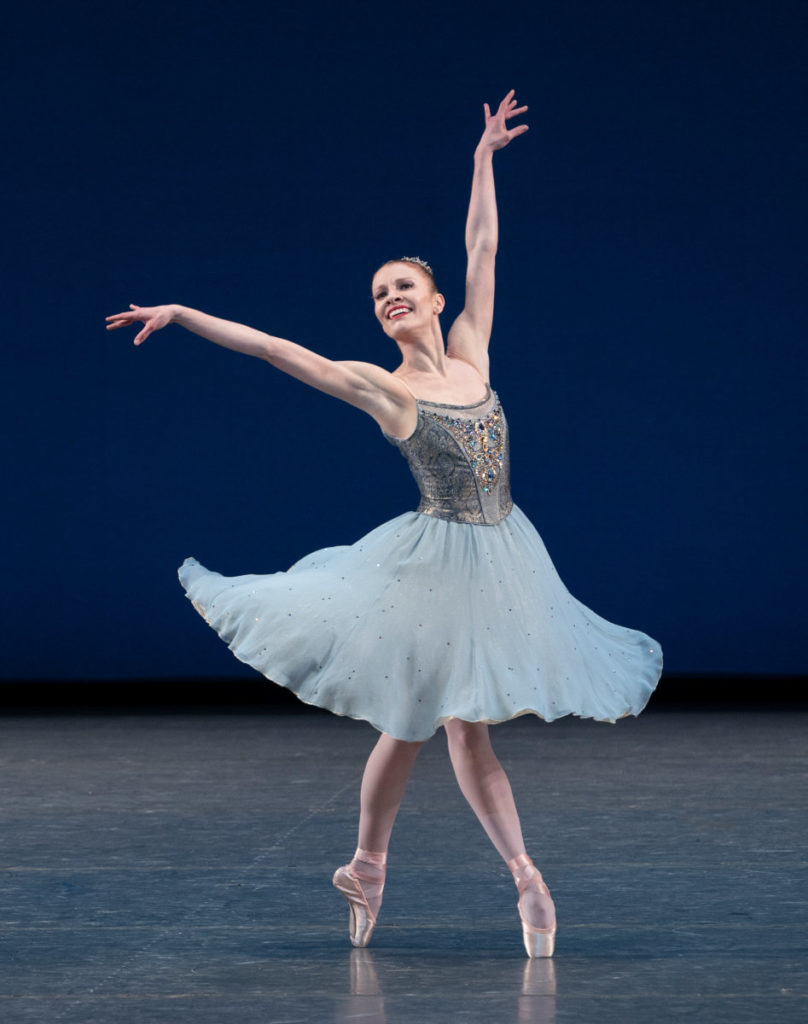
Lauren King in George Balanchine’s TSCHAIKOVSKY PIANO CONCERTO NO. 2 (Photo: Paul Kolnik)
Well, almost. The costumes for Tschaikovsky Piano Concerto No. 2, which have been overhauled several times since its 1941 premiere, are a fizzle. The rippling chiffon skirts distracted from the intricate footwork and looked too boudoir-casual for this grand affair that retains a faint whiff of empire. (It didn’t used to be called Ballet Imperial for nothing.) Troweling bushels of Swarovski crystals on to the bodices just sent mixed signals. The men fared no better in fancy vests that were very Siegfried-and-Roy at the Mirage in Vegas.
The tweaking of the frost blue tulle skirts in Serenade, however, is a hit. Panels in a shade of lemon meringue have been inserted into the skirts, adding a faint striation to the cirrus cloud-like layers – as if to let a hint of sunshine through. The effect is sheer heaven. As was the dancing on Thursday night by the 20 heroines of Serenade. In an eerie liminal space conjured up by George Balanchine, that is neither earthly nor celestial, the dancers embodied contradictory qualities of introspection and passion, attack and airiness.
Helming the enterprise was Sterling Hyltin, who shipped in on a moonbeam, cerebral and ethereal but also hard as diamonds, capable of reckless speed in her traveling turns and daring as she tilted off-balance on her pointes. Superb assist was provided by Megan LeCrone, who deployed her long arms and broad shoulders magnificently, fired off big, bold sissonnes, and plunged into breathtaking backbends. She smoldered, but without operatics that would’ve killed the otherworldly vibe. The fleet Erica Pereira made a striking contrast, with her darting piqués, and feet that eloquently stroked the floor as if preparing to launch her into flight.
The sprinkling of men in this ballet play largely self-effacing roles, their blue leotards and tights disappearing against the blue cyclorama. Nevertheless, Preston Chamblee made a powerful impression as the blindfolded man who comes in and out of Sterling Hyltin’s life, escorted by an angel of death. Ask la Cour on the other hand looked alternately bored and petulant. When he first approached Hyltin, he was meant to tap her gently on the shoulder to let her know he was there, at her service. But la Cour gave Hyltin more of an impatient rap, as if he were serving her a subpoena.
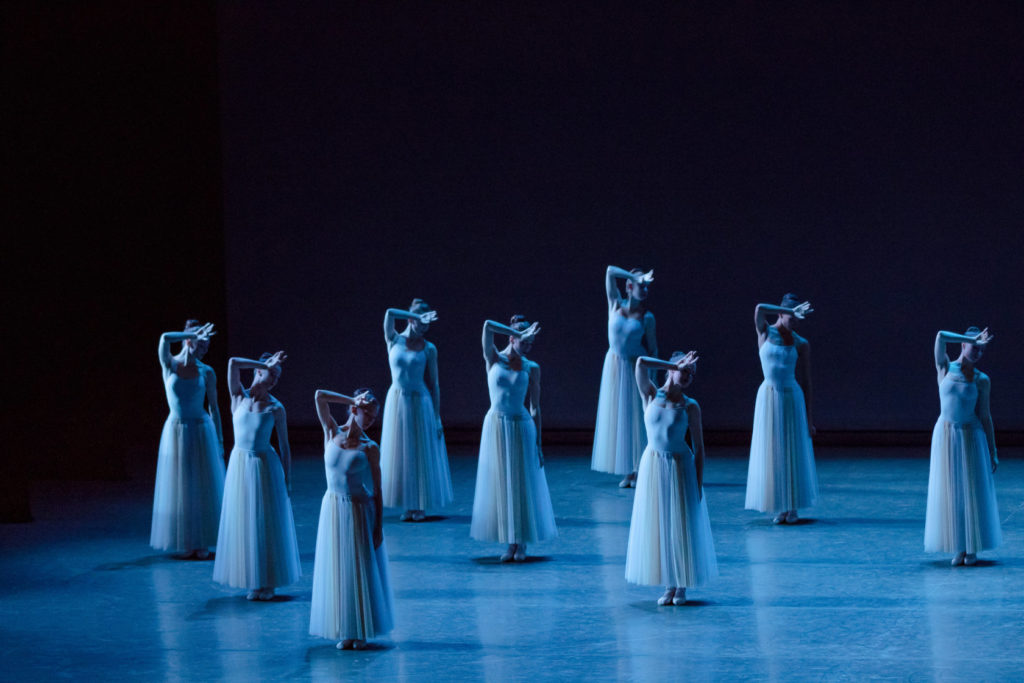
New York City Ballet in George Balanchine’s SERENADE (Photo: Paul Kolnik)
PC No. 2, the second iconic Balanchine work on the program, is, in contrast to Serenade, a very worldly ballet, all flash and elegance, enormous tiaras and courtly manners. On Thursday night Lauren King played crown princess to Ashley Bouder’s queen, both sailing through their highly caffeinated choreography with ease and near-flawlessness. Elaine Chelton at the piano made a spirited co-conspirator.
King was radiant throughout, vivacious and springy. She was also remarkably serene in a perilous promenade on pointe, steered jointly by the cocky Christopher Grant and Alec Knight – dueling suitors who figured that would be a fine moment to show off their grands jetés.
Bouder, with her smoking footwork and stop-on-a-dime finishes, made a virtue of untidy arms in one tour de force after another. In the first movement she treated Russell Janzen more like her prime minister than her cavalier (one brief embrace notwithstanding.) He was clearly hoping that their relationship would take a more romantic turn, and told her as much with strings of noble beaten jumps. But she had matters of state to attend to and left Janzen to dance the beguiling slow movement hand in hand with the corps women, who amplified his loneliness in a gently undulating wave that stretched across the stage. Bouder did return for an intimate rendezvous in which Janzen flung her about with ardor, heightening her expansive whipping jumps with only a handhold to tether her. This daring feat of partnering was echoed by the amassed courtiers in the final glorious movement.
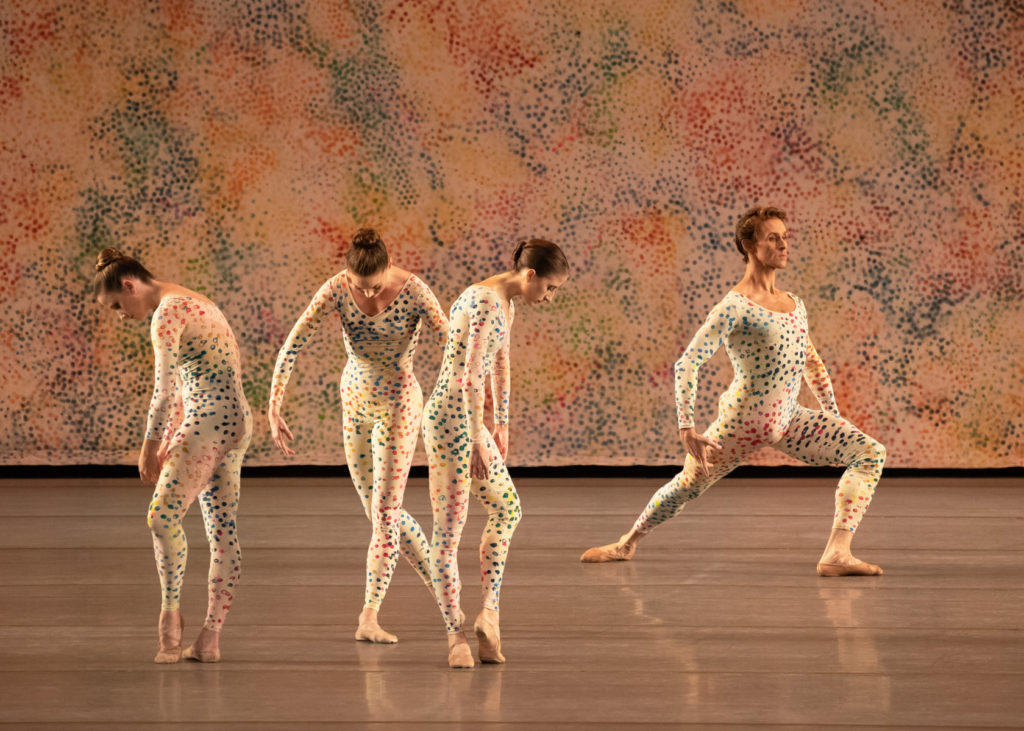
Abi Stafford, Emily Gerrity, Sara Adams, Adrian Danchig-Waring in Merce Cunningham’s SUMMERSPACE (Photo: Erin Baiano)
Sandwiched between these two iconic Balanchine works, Merce Cunningham’s Summerspace evoked an arcadian landscape in which dancers were neither aristocrats nor spectral figures but intimations of birds, insects and other fauna. The work has made a comeback at City Ballet after outings in 1966 and 1999. Sara Adams, Adrian Danchig-Waring, Emilie Gerrity, Abi Stafford, Andrew Veyette, and Lydia Wellington may not exhibit the gravity of Cunningham’s dancers, but on Thursday night they made Summerspace exquisitely their own.
To composer Morton Feldman’s halcyon accumulation of twittering, susurrating and plinking sounds, they threaded independent paths across the stage, only rarely pausing to contemplate another dancer and almost never touching, deep in thought as they negotiated imaginary rocks, tree limbs and streams. As they hopped on one leg, leapt and twisted and whirled and held precarious balances, they used ballet vocabulary but without many of the impulses, preparations, and counter-balancing tensions that normally get them through ballet movement.
It’s not often that ballet dancers are called on to sink into a pistol squat but Gerrity brought grit to it. Danchig-Waring found new power in his jump – notably the heroic one in arabesque in which he has to pull up his jumping foot. Wellington moved through positions serenely, yet with fierce concentration. Stafford reveled in heady spins, put weight into her movement, and carved shapes with a bracing clarity, as when she plunged to the ground to strike the posture of a roosting bird.

Adrian Danchig-Waring in Merce Cunningham’s SUMMERSPACE (Photo: Erin Baiano)
From the 3rd Ring, one lost the full visual impact of the designs by Robert Rauschenberg. The dancers’ stippled costumes are meant to merge into the stippled backdrop but, from a height, Rauschenberg’s colossal scenic drop appeared to hang above the dancers. That disappointment was offset by the pleasure of watching the kaleidoscoping geometries of the ensembles in Serenade and PC No. 2, on a night of stellar dancing.
– Carla Escoda reviewed Masters at Work: Balanchine & Cunningham at New York City Ballet on Oct. 10, 2019 –


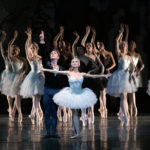

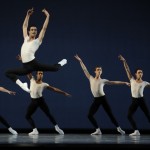

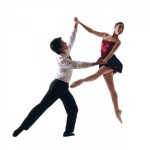
Well. You must be the only person who likes the new skirts in Serenade. At least you give a reason. Most people who hate them can’t say why they hate them except it’s new and it’ s not what Mr Balanchine would like. I don’t like them because they look like striped skirts and stripes are too busy for this ballet that should be simple. I also think it’s strange that you talk about the costumes first. Are costumes more important than the choreography? More important than who was cast and how did they dance? More important than the music?
I’ve heard many complaints about those skirts!
The way they were lit on Thursday night they didn’t look like stripes to me. But, as #ShoeGate proved, we don’t all see colors the same way 🙂 (https://yp.scmp.com/news/science/article/112887/science-behind-shoegate-explains-why-some-people-see-grey-and-others-see)
You asked the same question that my editor asked! No, I don’t think costumes are more important than other elements, but they’re part of the visual impact of dance so they’re important. Can you imagine Serenade in tights and leotards or a short tunic or a pancake tutu?
Very entertaining. You have an appetite for so many different things in dance, very broad-minded, but when you go in for the kill, it’s a surgical strike. I loved Serenade and I will never laugh at something as hard as I laughed at the picture of a guy in tights rapping a woman on the shoulder like he was handing her a subpoena. Thank you for brightening my day.
You’re welcome. And thank you in return for the surgical strike imagery. I’m going to use it someday in a review. Very useful to describe something in a performance that is off but doesn’t affect the larger impact of the work.